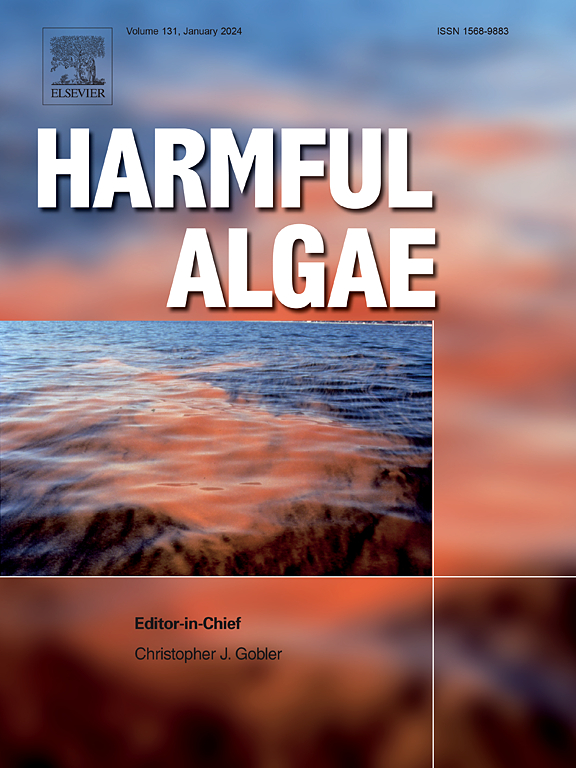Deciphering nonlinear effects of climate and eutrophication synergies on Microcystis blooms using a causal inference framework
IF 4.5
1区 生物学
Q1 MARINE & FRESHWATER BIOLOGY
引用次数: 0
Abstract
Harmful cyanobacterial blooms (CyanoHABs) pose a significant threat to global water quality. Although eutrophication and climate change are recognized as key drivers of CyanoHABs proliferation, their synergistic effects remain elusive, hindering effective mitigation strategies. Here, we present a causal inference framework that leverages state-space reconstruction and empirical dynamic modeling to unravel the complex, nonlinear interactions governing CyanoHABs dynamics. Focusing on Microcystis blooms dynamics in Dianchi Lake (China), our approach uniquely integrates causal inference with time-series embedding, reconstructing the ecosystem’s hidden dynamics in a higher-dimensional geometric space. This foundation enables us to rigorously quantify causal drivers—such as nutrient loading and temperature—while overcoming the limitations of traditional correlation-based analyses. Our causal network analysis reveals distinct nonlinear responses of chlorophyll-a (Chl-a) concentration and Microcystis density to different nutrient drivers. Specifically, we found that in-lake total phosphorus (TP) exerts a stronger causal influence on overall algal dynamics than total nitrogen (TN). In contrast, external nutrient loading shows greater influence over Microcystis density compared to in-lake nutrients. Through scenario simulations, we further demonstrate that rising air temperatures amplify Chl-a concentration and Microcystis biomass through increased water temperatures, whereas precipitation-induced nutrient changes preferentially stimulate Chl-a production over Microcystis growth. Notably, we identified contrasting seasonal response patterns, with Chl-a exhibiting greater sensitivity to dry-season conditions while Microcystis density responded more strongly to wet-season drivers. By bridging mechanistic understanding and predictive modeling, our work offers a transformative tool for forecasting and managing CyanoHABs in changing climates.
利用因果推理框架解读气候和富营养化协同作用对微囊藻华的非线性影响
有害的蓝藻水华(CyanoHABs)对全球水质构成重大威胁。虽然富营养化和气候变化被认为是蓝藻有害藻增殖的主要驱动因素,但它们的协同效应仍然难以捉摸,阻碍了有效的减缓战略。在这里,我们提出了一个因果推理框架,利用状态空间重建和经验动力学建模来揭示控制蓝藻藻动力学的复杂非线性相互作用。本文以滇池微囊藻华动态为研究对象,将因果推理与时间序列嵌入相结合,在高维几何空间中重构生态系统的隐藏动态。这个基础使我们能够严格量化因果驱动因素,如营养负荷和温度,同时克服传统的基于相关性分析的局限性。因果网络分析揭示了叶绿素a浓度和微囊藻密度对不同营养因子的非线性响应。具体而言,我们发现湖内总磷(TP)对整体藻类动态的因果影响强于总氮(TN)。与湖内营养物相比,外部营养物负荷对微囊藻密度的影响更大。通过情景模拟,我们进一步证明,气温升高通过水温升高增加了Chl-a浓度和微囊藻生物量,而降水引起的营养变化优先刺激了Chl-a的产生,而不是微囊藻的生长。值得注意的是,我们发现了不同季节的响应模式,Chl-a对旱季条件更敏感,而微囊藻密度对雨季驱动因素的响应更强烈。通过连接机理理解和预测建模,我们的工作为在变化的气候中预测和管理蓝藻藻提供了一个变革性的工具。
本文章由计算机程序翻译,如有差异,请以英文原文为准。
求助全文
约1分钟内获得全文
求助全文
来源期刊

Harmful Algae
生物-海洋与淡水生物学
CiteScore
12.50
自引率
15.20%
发文量
122
审稿时长
7.5 months
期刊介绍:
This journal provides a forum to promote knowledge of harmful microalgae and macroalgae, including cyanobacteria, as well as monitoring, management and control of these organisms.
 求助内容:
求助内容: 应助结果提醒方式:
应助结果提醒方式:


